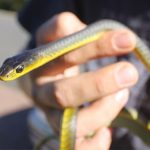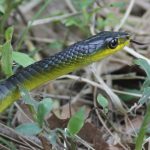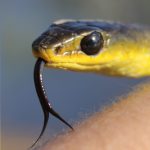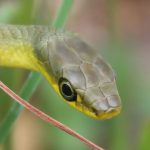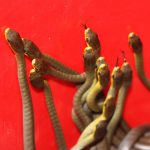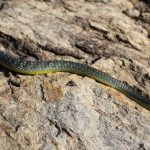DESCRIPTION – Often greenish but varying from golden yellow and grey headed in the north through to black, brown, olive, even pale blue. Blue/light flecks seen between body scales, particularly when threatened, often with bright yellow faces, throats and ventral surfaces. Large eyed, with relatively thin, elongate body and head. Grows to 2 meters, 13 mid body scales, rarely 11 or 15. 180-230 ventral, 100-150 sub ventral, anal divided. Family: Colubridae.
DISTRIBUTION – Often lush vegetation and areas near water, including sclerophyll forest, rainforets, heathland, creeks, waterways, swamps, mangroves and grasslands. Throughout Australia’s northern tropics , including the NT’s Kimberly region, to the Torres Straits and PNG, and down south along eastern Australia to southern New South Wales. Common around suburban gardens.
ECOLOGY – Diurnal. Largely arboreal, feeding mostly on frogs, lizards, and occasionally fish. With no fangs or venom, rely on teeth and constriction or simply eat prey alive. Oviparous, 5-14 eggs.
VENOM – NON-VENOMOUS.
Updated November 2019 from Eipper, S. & Eipper, T. (2019) A Naturalists Guide To The Snakes Of Australia. John Beaufoy Publishing.

